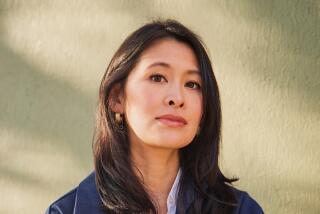Book review: ‘The Great Wall of Lucy Wu’ by Wendy Wan-Long Shang
- Share via
The Great Wall of Lucy Wu
A Novel
Wendy Wan-Long Shang
Scholastic Press: 312 pp., $17.99
Eleven-year-olds aren’t known for being accommodating. As a whole, this subspecies known as “tween” is self-interested and self-conscious, a deadly combination that shuns anything that prompts embarrassment, such as a wrinkled old lady with Brillo pad hair who can’t communicate in English and looks as foreign as she is.
In the humorous new middle-grade novel “The Great Wall of Lucy Wu,” an 11-year-old girl is challenged to overcome her innate tween dismissiveness and balance the two forces that define her. A second-generation Chinese American, Lucy Wu has relegated China to “the hyphenated place in my life” between the two cultures. While her college-bound sister has “practically majored in Being Chinese” and her brother is, predictably, a math whiz, Lucy prefers basketball to violin. She’d rather eat lasagna than dim sum. And she struggles to understand her parents when they banter in Mandarin.
Lucy is a Twinkie, according to her older sis: “Yellow on the outside, white on the inside.” And that’s just the way Lucy likes it. Her Chinese heritage isn’t anything she values or even thinks about unless she’s forced to.
But when her parents invite an ancient relative to live with them for a while, and to share Lucy’s room, the Chinese part of Lucy’s life begins to become more than just a hyphen. It is, at first, against Lucy’s will, thus the Great Wall. Just before her great aunt Yi-Po arrives at their home from Shanghai, Lucy rearranges her bedroom, pushing a desk and bookshelf into its center to divide the room in two.
Yi-Po was an unwelcome presence in Lucy’s life even before she stepped foot on American soil for the first time, and Lucy’s prejudice against her is only solidified once she moves in. Yi-Po’s clothes, made of navy blue padded cotton, make her look “like a tumbling mat with hair.” Her radio station of preference is WCHI, an all-Chinese station she listens to nonstop.
Worst of all, she smells like Vicks VapoRub.
At age 11, Lucy is still respectful enough of her parents to abide by their wishes, even if she doesn’t agree with the choices they make for her life. Yi-Po is just one example. They also insist she attend Chinese school.
Over the course of a well-paced book that plays the usual obstacles to middle-grade happiness to great effect — siblings, parents, mean girls — Lucy slowly connects to her Chinese-ness. Yi-Po, through small gestures of kindness that transcend her verbal communication skills, demonstrates her value to Lucy. It helps that Lucy, like most girls this age, is heavily influenced by her friends who’ve taken an interest in Yi-Po, specifically her amazing dumplings.
Written in the first person from Lucy’s point of view, “The Great Wall” has a delightfully pessimistic tone that leavens dread with humor. In Lucy Wu, author Wendy Wan-Long Shang has accomplished something quite difficult: She’s made a girl who constantly feels sorry for herself extremely funny and relatable as Lucy attempts to strike a balance between parental expectation and self-fulfillment, her Chinese heritage and the American lifestyle.
A new author who wrote “The Great Wall” with the help of a Work-in-Progress Grant from the Society of Children’s Book Writers and Illustrators, Wan-Long Shang writes with linguistic playfulness. When Lucy first rearranges her room, she describes her decorative style as “I can’t find my math homework.” When Lucy gets to school one day hoping to find her crush but instead locates her arch rival, she says, “I had two simultaneous thoughts. Look for Harrison, avoid Sloane.... Unfortunately, I couldn’t look for Harrison because something blocked my view: Sloane.”
A delightful story about assimilation and family dynamics, “The Great Wall of Lucy Wu” is sure to appeal to young readers struggling with issues of self-identity, whatever their heritage. .


